Xi'an, a thousand-year-old Internet celebrity city

Meet Xi'an
Eight hundred miles of Qinchuan is dusty, and 30 million old Shaanxi and Qi are roaring Qin opera. Since the establishment of Fengjing and Haojing capital in the Qin Dynasty, Xi'an has always been a hot Internet celebrity city. The historical and cultural heritage of the ancient capital of the thirteen dynasties has made Xi'an ancient city where countless people compete to check in.
In 14 years, I passed by Xi'an and stayed briefly for a day. Six years later, Xi'an, which was blessed with bowls of wine and little lady tumbler, once again became popular on the Internet. Chang 'an is a dream in the hearts of Tang Dynasty people; Xi'an is the Chang 'an dream in the hearts of modern people!

There is more than 6,000 years of Yangshao Culture in Banpo here

Here are the breathtaking views of the Qin Terracotta Warriors

Here is the thickness of Han cultural relics

Here is the prosperity of Chang 'an's prosperous times

Here is the grandeur of the Ming Great Wall

Here are the bright lantern festivals that build the ancient city against mountains and rivers


Here is the brightly lit Tang City that never sleeps



Here are three days of endless Shaanxi cuisine


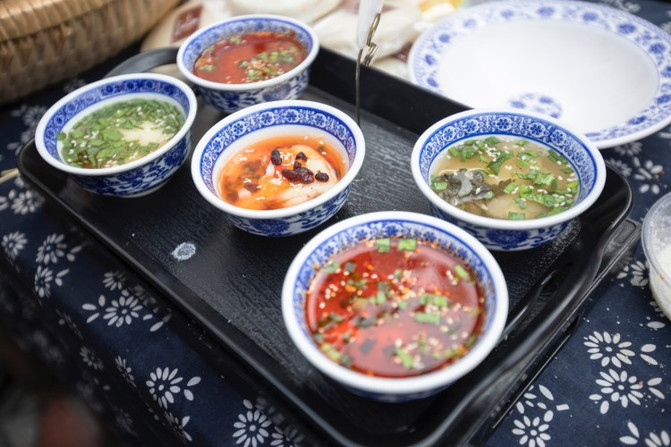
Here are national check-in bowls of wine and tumblers

about traffic

Xi'an can be reached by high-speed rail.
Railway Station:
There are three railway stations in Xi'an: Xi'an Railway Station, Xi'an South Railway Station and Xi'an North Railway Station. Xi'an Station is the main railway station, and all trains ending in or passing through Xi'an in Wuhan (departing from Wuhan/Wuchang/Hankou) currently get off at Xi'an Station. Xi'an North Railway Station is the boarding and unloading station for Zhengxi high-speed trains. Xi'an South Railway Station is the boarding and unloading station for some trains on the Xikang Railway.
Airport:
Xi'an Xianyang International Airport: It is relatively far away from Xi'an urban area and about 30 kilometers away from the center of Xi'an City (Bell Tower). You can take the airport bus and intercity subway from the airport.
itinerary
Day 1: Suzhou to Xi'an
Xi'an City Wall New Year Lantern Festival in the evening
The next day:
Morning: Banpo Museum
Afternoon: Terracotta Warriors Museum
Evening: Huaqingchi Tang Palace Lantern Festival
Day 3:
Morning: Seoul Lake Park
noon: Yongxing Square
Afternoon: Bell and Drum Tower
Evening: Tang Dynasty Furong Garden, Tang Dynasty Sleepless City
Xi'an city wall
It was about 2 o'clock from Suzhou to the hotel where I stayed in Xi'an. After taking a short rest at the hotel, go to the Xi'an City Wall Scenic Area to enjoy the Xi'an City Wall New Year Lantern Festival, which has just begun to light up.
Compared with the Ming City Wall in Nanjing, although the scale of Xi'an City Wall is small, it retains a complete shape. The tower and arrow towers are well preserved. Xi'an Ming City Wall is the "largest existing and most completely preserved" ancient city wall.

It takes about 3-4 hours to walk around the city wall. You can also rent bicycles and fly kites on the city wall. There are many enemy towers and arrow towers on the city wall, and most of them are relatively intact.

The Xi'an City Wall retains all four barns, which are large in scale and exquisite in architecture. The Ximen Tower, Dongmen Tower, and Nanmen Tower are all relics of the Ming Dynasty wooden structure towers. The arrow towers of the east, west and north gates are also well preserved. Among them, the arrow towers of the Andingmen Tower can be called a masterpiece, and the wooden carved beams of the tower can be clearly seen in the Ming Dynasty.

[South Gate·Yongning Gate]
It is recommended to climb the building from the south gate, because you can reach the south gate of the city wall not far from walking from the Bell Tower. There are many things to see on the south city wall. The Forest of Steles, Shuyuan Gate, and Xiama Mausoleum are all near the Duanlu Gate of the south city wall. There is a museum inside the city wall of Hanguangmen.
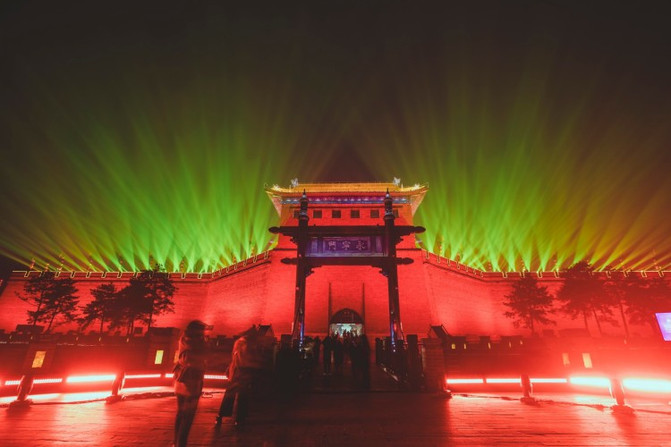
There are three performances at the Yongning Gate at the south gate of the city wall, namely "Dream Chang 'an-Tang Dynasty Welcome Ceremony", warrior stand patrol, and warrior change ceremony. There is a lantern festival at the south gate and the city wall every year during the Spring Festival on the Yuan Festival.

[North Gate·Dingyuan Gate]
The north gate of Xi'an City Wall is Anyyuan Gate. The north gate built during the construction of the city wall in the Ming Dynasty is located on the north-south axis of Xi'an City. It is the most iconic gate of the northern city wall. As far back as the Tang Dynasty, it was the main gate for welcoming guests. It is called the "First Gate of the Ancient City".

[East Gate·Changle Gate]
Changle Gate, the main east gate of Xi'an City Wall, is located south-by-south of the middle of the East City Wall. From the 7th to the 11th year of Hongwu of the Ming Dynasty (1374 to 1378), Changle Gate was built during the expansion of Xi'an Prefectural City. Later, the Qing Dynasty and the Republic of China were held to this day. Today, Changle Gate houses the Wengcheng, Arrow Tower, Main Tower and Double Gate Entrance.

[Ximen·Andingmen]
The Anding Gate site was originally the "Shunyi Gate", the middle gate to the west of the Imperial City of Chang 'an in the Sui and Tang Dynasties. It was preserved when Han built a new city in the late Tang Dynasty. From the 7th to the 11th year of Hongwu of the Ming Dynasty (1374 to 1378), Xi'an Prefectural City was expanded. This gate was used as the West Gate and renamed "Anding Gate". Today, Anding Gate houses Wengcheng, Jianlou, Zhenglou and Double Gate Entrance.

Three ticket holes are opened on both sides of the gate for vehicles and pedestrians to pass through. There is Kuixing Tower built on the city wall of Wenchang Gate. Wenchang Gate is a forest of steles, and Zhongshan Gate (Xiaodongmen Gate) is Yongxing Square, which is an Internet celebrity and a bowl of wine. The street in Zhongshanmen is called Dongxin Street, which is also a food street!

As depicted in "Chang 'an Twelve Hours", in Chang' an City in the Tang Dynasty, the most lively event of the year was the Shangyuan Festival. The moonlight lights fill the imperial capital, and the fragrant carriages and carriages pass the thoroughfare."Tang Xin Yu" records that every year on the Lantern Festival, lanterns are set up in Chang 'an City, and the curfew is lifted on the night of the three days before and after. The entire Chang' an City is like day all night long, brightly lit, the monarch and the people celebrate together, and thousands of people are empty!

The fire trees and silver flowers are closed, and the iron lock of the star bridge is opened. Dark dust follows horses, and bright moon follows people. All wandering singers are plums, and all singing are plums. The gold cannot help but stay at night, and the jade leaks don't rush each other. The Lantern Festival in Xi'an is the most magnificent one I have ever seen. It is numerous in number, wide in area, diverse in style, rich in humanities, and new in technology. It almost exerts the power of the whole city and cleverly integrates the city wall, Lishan Mountain, Quchi, and Shijing City, restoring the brightly lit prosperous Tang Dynasty, like a modern version of Chang' an City that never sleeps.

Xi'an's oldest New Year Shangyuan Lantern Festival should be the Xi'an City Wall New Year Lantern Festival. It has been held for more than 30 years now and has indeed become a growing memory of one or two generations of people in Xi'an.

This year's 33rd Gengzi New Year Lantern Festival still centers on Yongning Gate at the south gate of the city wall. Yongning Gate at the south gate of the Xi'an city wall is the only remaining gate with a gate tower. The lantern square in front of the gate tower is shining with stars and bright lamp posts.

Xi'an city wall

Xi'an city wall

In Shengshi Chang 'an District, Happy Prayer District, Splendid China District, Dream Children's Truth Lantern District, and Liuguang Ancient and Modern District, colorful lanterns with five major themes illuminate the entire South City Wall area.

Passing through the gate tower, you will enter the Yuecheng·The dazzling "Flying Music and Dance" lantern lamp lamp set and the majestic and spectacular tower tower. Several women in the flying shape seem to have traveled from Dunhuang, their clothes fluttering, and the colorful Baoxiang flowers bloom layer by layer to reproduce the grand scenery of the Silk Road.
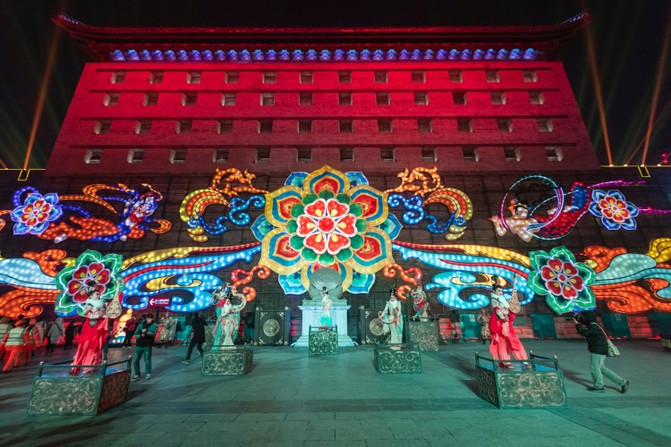
Xi'an city wall

Passing through the gate tower, you will enter the Yuecheng·The dazzling "Flying Music and Dance" lantern lamp lamp set and the majestic and spectacular tower tower. Several women in the flying shape seem to have traveled from Dunhuang, their clothes fluttering, and the colorful Baoxiang flowers bloom layer by layer to reproduce the grand scenery of the Silk Road.

Xi'an city wall

Xi'an city wall

Xi'an city wall

Xi'an city wall

Climbing the city wall, you will find two promenades of the "Prayer Lantern Corridor" on both sides of Weng City. The promenades are filled with palace lanterns, and everyone stops here to take photos.

Xi'an city wall

Xi'an city wall
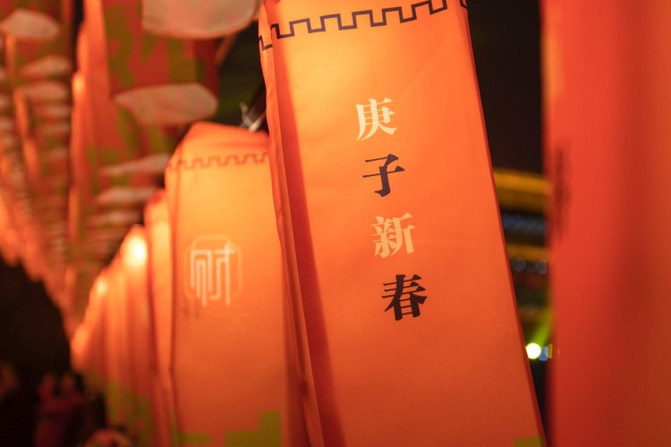
Climb the city wall and stroll eastward, fully displaying the children's fantasies about Chang 'an. The galloping horses are marching forward, and the luxurious silk ribbons seem to be fluttering in the wind. Everyone is surrounded by thousands of lanterns. Polo, presenting a magnificent picture of Chang' an in a prosperous age.

Xi'an city wall

Xi'an city wall
Xi'an city wall

Xi'an city wall

Xi'an city wall

Xi'an city wall

Xi'an city wall

The giant Shengshi Baoding shape is made of 150,000 colorful small glass bottles. It is grand and magnificent, bursting with a prosperous scene of thousands of purple colors and floating light and gold.

Xi'an city wall

Xi'an city wall

Xi'an city wall

Xi'an city wall

Xi'an city wall

Xi'an city wall

Xi'an city wall

Xi'an city wall

Xi'an city wall

The pattern of treasure phase expresses its wish, the peony flowers bloom to overthrow the country, the brilliance adds to the vitality of the ancient city, and the spring is full of bloom and prosperity. Look, the brilliance is brilliant. Listen, the flowers bloom and sound, implying that the bright brilliance accumulated in the ancient city is dazzling on the land of China. In full bloom.

Xi'an city wall

Xi'an city wall

Xi'an city wall

Walking west of Wengcheng, the portrait walks into the place where the fairy tale takes place. Butterflies and bees dance here. Based on mushrooms, little samurai, and small animals, the anime images with cheerful expressions and diverse postures exude charming charm.
Xi'an city wall

Xi'an city wall

The lovely Shukbetta instantly regained his childhood memories.

Xi'an city wall

Xi'an city wall

The theme of thousands of lights is filled with lanterns and riddles of the Year of the Rat.

Xi'an city wall

Xi'an city wall
The light feast above the city wall has a unique charm. Rows of lanterns light up the edge of the city. The bright lights and the towering city gate and arrow towers complement each other. The blue bricks and tiles tell the legend of the ancient city in the night.
Ramada Plaza Hotel Qujiang Xi'an
Accommodation in Xi'an is relatively cheap. You can choose to stay in a B & B near the Bell and Drum Tower. The price is cheap, but the conditions cannot be too high.
This time we chose the Ramada Hotel near the most developed southern suburbs of Xi'an.

The star-rated hotels in the Accor hotel system can ensure a better overall accommodation experience.

The room is relatively large and the central air conditioner is running at full power.

Ramada Plaza Hotel Qujiang Xi'an

Ramada Plaza Hotel Qujiang Xi'an

The office area near the window is also more suitable for business trips.

Ramada Plaza Hotel Qujiang Xi'an

Unique bathroom space design increases the depth and extension of the room

Ramada Plaza Hotel Qujiang Xi'an

Ramada Plaza Hotel Qujiang Xi'an

Ramada Plaza Hotel Qujiang Xi'an

Ramada Plaza Hotel Qujiang Xi'an

Ramada Plaza Hotel Qujiang Xi'an

Ramada Plaza Hotel Qujiang Xi'an

The buffet on the first floor of the hotel is very good, the environment is decorated with a high-end atmosphere, and the space is also cleverly divided, increasing the sense of privacy.

Ramada Plaza Hotel Qujiang Xi'an
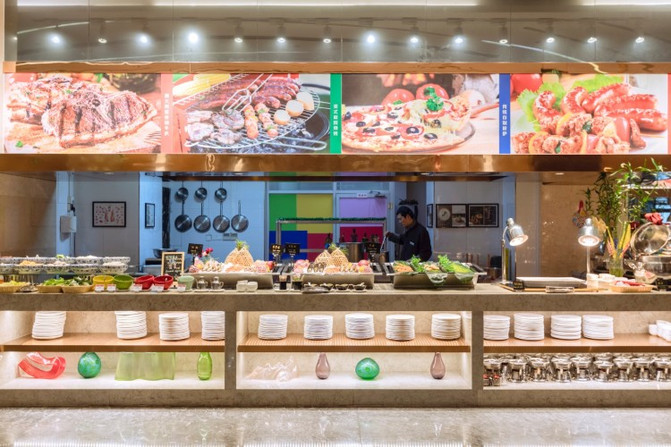
Ramada Plaza Hotel Qujiang Xi'an

Ramada Plaza Hotel Qujiang Xi'an

Ramada Plaza Hotel Qujiang Xi'an

Ramada Plaza Hotel Qujiang Xi'an

Breakfast, lunch and dinner are available. There are a wide variety of food, including Chinese food, Western food, Japanese food, Xi'an local food... the taste is also very good, and the ingredients are quite fresh.

Ramada Plaza Hotel Qujiang Xi'an

seafood

Ramada Plaza Hotel Qujiang Xi'an

Ramada Plaza Hotel Qujiang Xi'an

Ramada Plaza Hotel Qujiang Xi'an

Ramada Plaza Hotel Qujiang Xi'an

Ramada Plaza Hotel Qujiang Xi'an

Ramada Plaza Hotel Qujiang Xi'an

Ramada Plaza Hotel Qujiang Xi'an

Ramada Plaza Hotel Qujiang Xi'an

Day 2: Banpo Museum
Xi'an, the ancient capital of the Thirteen Dynasties with a profound history, has more than 200 museums of various sizes. In addition to the Shaanxi History Museum, there are also a number of niche museums worth visiting. There are 9 national-level museums in Shaanxi Province, of which Xi'an owns the sixth. They are Shaanxi History Museum, Qin Shi Huang Mausoleum Museum, Xi'an Forest of Steles Museum, Xi'an Museum, Xi'an Banpo Museum, and Xi'an Datang West City Museum.
Banpo Museum is one of them. It originated from the Banpo Ruins and is located in the north of Banpo Village in Chengzhong Village. It is a relatively complete site in the Yellow River Basin with an existing area of about 50,000 square meters. It is divided into residential areas, pottery making areas and tombs. area. You can experience the daily life of primitive people.

6000 years ago, it was a primitive village of a matriarchal clan. Men and women worked in their respective clans during the day, and the man went to the woman's house for the night until he gave birth to a child. He only knew that his mother did not know his father, that women led society, and that he was buried with the same sex after death.
[Hall·Unearthed Cultural Relics Exhibition Hall]
The display of unearthed cultural relics consists of the first exhibition room and the second exhibition room. The two exhibition rooms display production tools and daily necessities unearthed from the site.

Banpo Museum
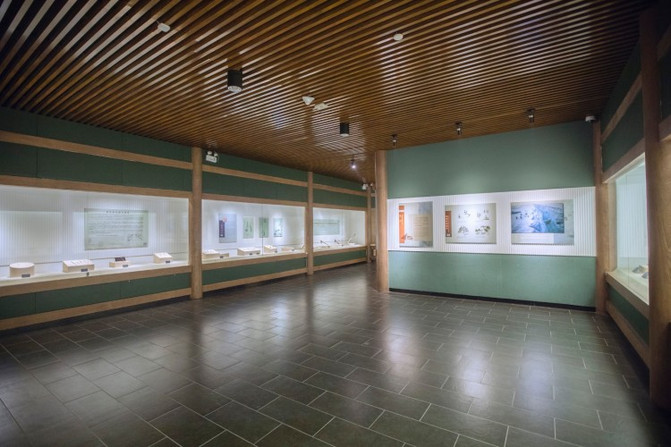
Banpo Museum
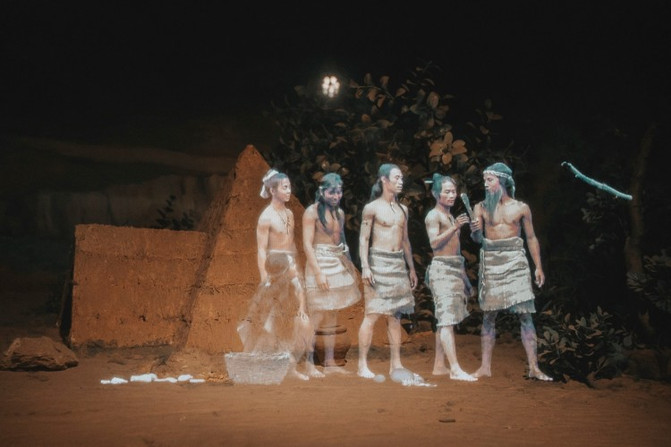
It mainly displays production tools, daily necessities and works of art used by the original ancestors unearthed from the Banpo Site and Jiangzhai Site, which can be divided into stone tools, bone utensils and pottery.


Banpo Museum

Banpo Museum
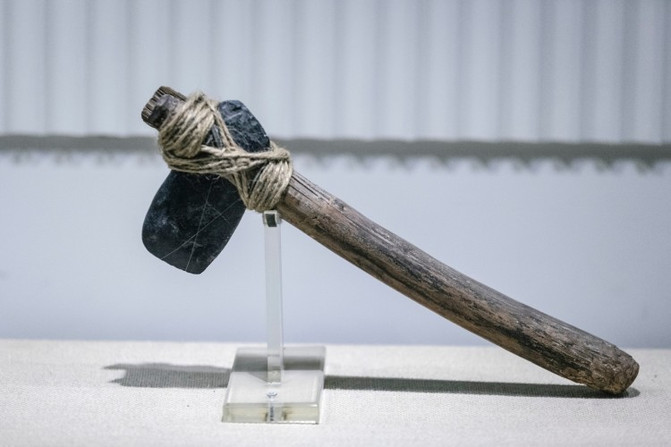
Banpo Museum

In the middle of the first and second exhibition halls, a huge semicircular area is set up to restore and show the scene of the life of primitive people in Banpo.

The treasure of the Banpo Museum is the human-faced fish pattern basin. The human-faced fish pattern basin is 16.5 cm high and 39.5 cm in diameter. On the inner wall of the pottery basin, two symmetrical human faces and two fish patterns are painted. The excavation site is located in the residential area of the Banpo Ruins. As for the meaning of the human-faced fish pattern on it and the use of the human-faced fish pattern basin, it has not been possible to sell directly, because the uniqueness and mystery of the human-faced fish pattern make it the most artistic value of the painted pottery decoration.

Vases with small mouths and sharp bottoms are the most typical artifacts of Banpo Culture. Many discoveries were made during the excavation of the Banpo Site in Xi'an, and there is also disagreement about its use.

Banpo Museum

A large number of colorful pottery can be seen from the Banpo site. The painting patterns are simple and concise, including elephant patterns and geometric patterns. Many of these patterns are symmetrically drawn, reflecting their aesthetic appreciation of painted pottery culture.

Nail pattern red pottery pot bird fish pattern colored pottery gourd bottle

Banpo Museum

[Hall·Banpo Ruins Hall]
Coming out of the exhibition hall is the ruins hall. The four characters "Banpo Remains Toe" were inscribed by Guo Moruo back then, but no one knows why the toes of the toes were used instead of the site.

Banpo Museum

In the early days of house construction, half of it was underground, and half of it was exposed to the ground with the pit wall as the wall. This kind of house was low and humid.

There is also a large chasm from the site that is more than 300 meters long, about 5 meters deep, and about 6 meters wide; this is a fortification to protect the village from invasion by foreign tribes and prevent sudden attacks by wild beasts.

In the late period of primitive society, walls were built on the ground and wooden pillars were used to support the roof. This upright wall and sloping roof had formed the basic model of later traditional Chinese house construction, which was a great move at that time.
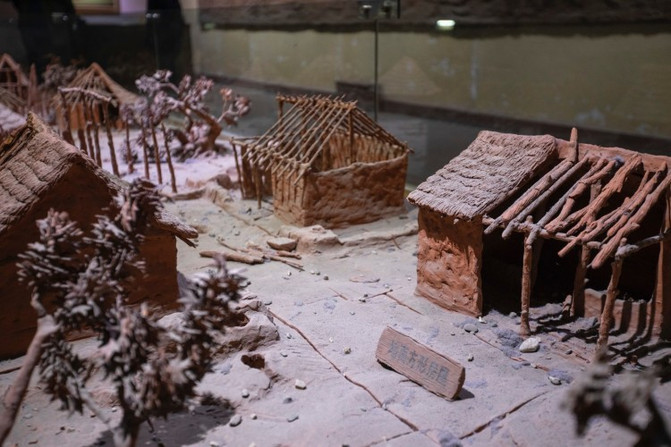
Public cemeteries can also be seen in the site. Some cemeteries have urns placed on them. The urns are covered with pottery pots. There is a small hole drilled in the middle of the pottery pots. After the death of a person, the bones are placed in the urns. The function of the small hole is to make it easier for the soul of the deceased to enter and exit.
[Garden·Study Experience]
Behind the Banpo Ruins Hall, many peonies are planted inside. It is also a study and experience park. There are special teachers to guide everyone to experience the lifestyle of primitive people, such as drilling wood to make fire, drilling stone tools, etc.

Banpo Museum

Banpo Museum

True Love Lishan's Daqin Feast
After visiting the Banpo Museum, drive to Lintong District to find and experience Qin culture. At noon, we can check in for the Daqin Small Banquet near the Terracotta Warriors Scenic Area, which will feature the Qin culture-themed banquet. It is said that Wang Jian and his son assisted the King of Qin in annihilating the six countries and were used in important positions. They were often given delicious food in the palace. The two of them received the imperial kindness and named the delicious food the Great Qin Xiaoyan.

Dressed in Qin costumes, playing the zither and singing the zither, in the classical banquet hall, tasting the delicacies with the characteristics of the Pre-Qin Dynasty.

True Love Lishan's Daqin Feast

You can choose to have separate meals for the theme banquet. Just like the eating style in the pre-Qin Dynasty, everyone sits face to face, the tableware is also quite colorful, the rice wine before the meal is particularly delicious, Lintong specialty pomegranate, and you can also eat stone buns.

Wang Jian Fish Roast, Lianpo Meatballs, Haojing Harmony Soup, Qin Palace Date Cake, Penglai Golden Melons... Each dish at the theme banquet has a story. Before each dish is suitable, a waiter wearing Qin clothes will explain the story behind it.

True Love Lishan's Daqin Feast

Roujiamo, Chincang cha cha, Ma Shi... authentic local snacks are naturally indispensable.

True Love Lishan's Daqin Feast
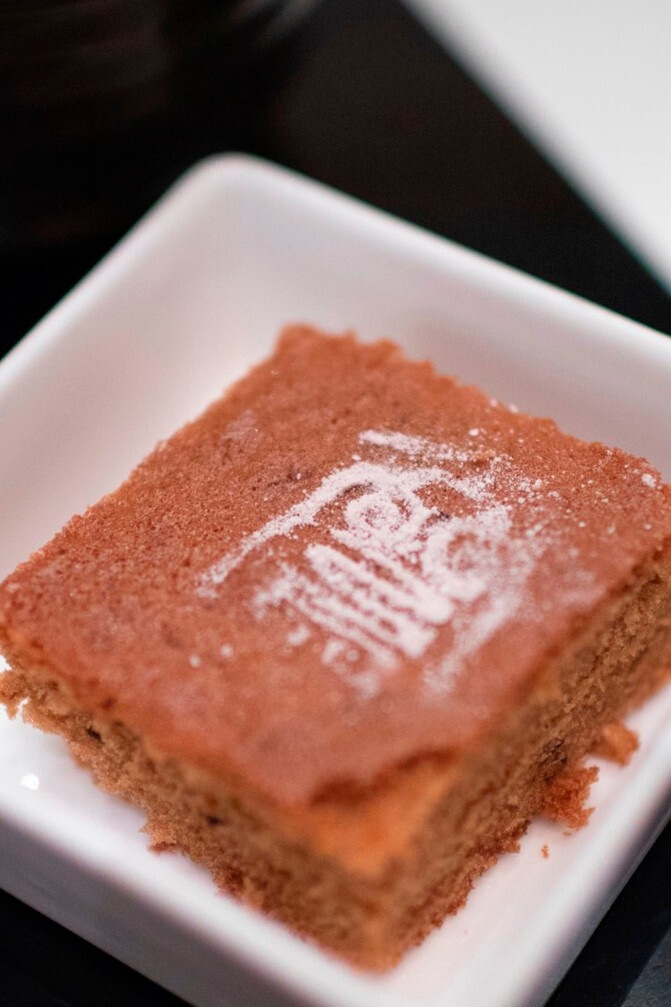
After the meal, you can stamp the menu with the red seal of "Order from Heaven, Live forever" and bring it back as a souvenir, full of ceremonial feeling.

True Love Lishan's Daqin Feast

the Terracotta Warriors and horses Museum
In Xi'an, the ancient capital of the 13th Dynasties, if you are looking for traces of Qin culture, the Terracotta Warriors and Horses of Qin Shi Huang is a check-in point that cannot be missed. The Terracotta Warriors and Horses are located in Lintong District, Xi'an, which is almost the farthest scenic spot from Xi'an. There is a direct train from Xi'an Railway Station.
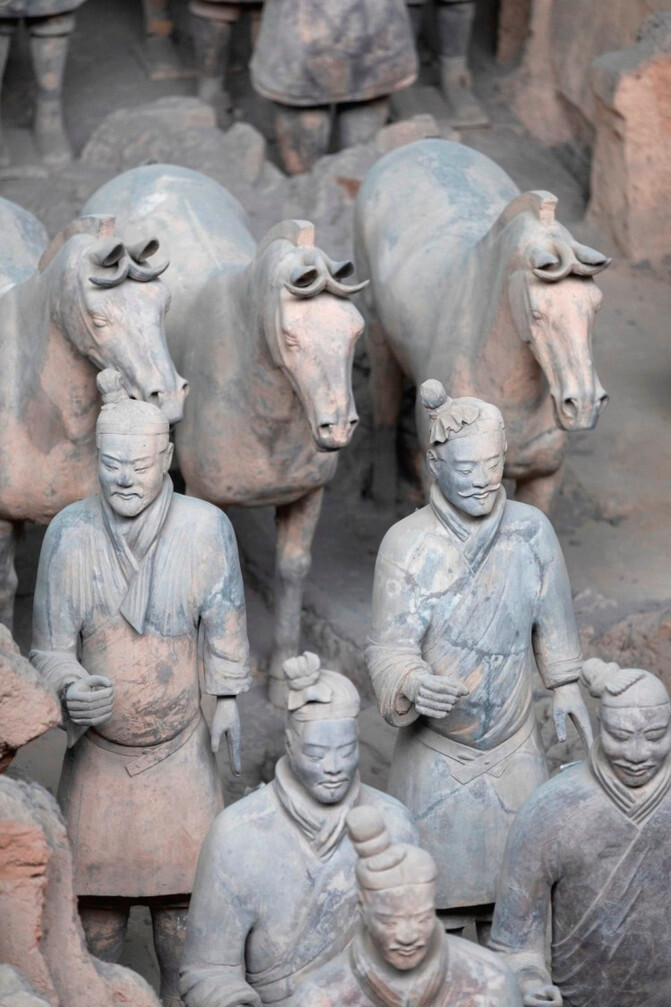
During the Warring States Period, Ying Zheng, the King of Qin, unified the six countries, took Xianyang as the capital. He chose the Mausoleum of the Emperor Qin Shi Huang on the verdant Lishan Mountain in Lintong. It took 720,000 migrant workers to complete the construction in nearly 39 years, covering an area of more than 56 square kilometers. This place is backed by mountains and rivers, and ancient jade grows from blue fields on both sides. Tongguan produces gold, which can be said to be a mountain with its head resting on its feet and a river with its feet. His ancestors have been senior officials for generations; he grasped gold with one hand and jade with the other. The Qin Emperor was buried for his good name.
Xi'an Qin Shi Huang Terracotta Warriors Museum includes two scenic spots: the Terracotta Warriors Museum and the Qin Shi Huang Mausoleum. The distance between the two scenic spots is 1.5 kilometers. One ticket includes the cost of visiting the two scenic spots and the round trip tour bus during the period.

Because too many people visit the Terracotta Warriors every day, this new entrance was built later. After checking in, you can walk or take the Jingjiao electric car to the old entrance.

After walking through a green park, I arrived at the original main entrance, which is a great place to take a group photo. It is said that the Terracotta Warriors Museum has a couplet: "Don't forget the GCD when you turn over, you all rely on Qin Shihuang to get rich." The horizontal comment is: "Thanks to Lao Yang. "Because it was a farmer named Yang who discovered the terracotta warriors while digging a well.

There are currently four pits and copper chariots and horses showrooms excavated in the entire museum. The fourth pit has been filled without the terracotta warriors. One said that the fourth pit is a centralized production workshop of terracotta warriors in other pits, and the other said that it is dilapidated.

In 1978, Chirac, mayor of Paris, lamented after visiting the No. 1 pit of the Qin terracotta warriors: "The Eighth Wonder of the World." According to incomplete statistics, millions of foreigners visit the Mausoleum of Qin Shihuang every year. Together, they can almost circle the Great Wall hand in hand. It is said that a German student cosplayed a terracotta warriors and jumped into the tunnel, but was not discovered by the staff.

Pit No. 1 is the earliest excavated pit with the largest exhibition area. Walking into the hall, you will suddenly see the tall, powerful, and serious-looking terracotta warriors. The entrance of the hall is the best viewing position, but now it is not allowed to enter the pit to visit, so it is a pity that you cannot observe these lifelike terracotta warriors up close.

The military formation of No. 1 pit consists of vanguard, main body, flank and defender. More than 6000 terracotta warriors and horses can be unearthed from all excavations. Each piece is made of the size of a real horse. The terracotta warriors are wearing armor or battle robes and are majestic. The horse seems to hold its head high and whistle, gathering its hooves to gallop.

the Terracotta Warriors and horses Museum

Due to their unique craftsmanship and spectacular lineup, the Terracotta Warriors are known as the Eighth Wonder of the World. More than 8000 Terracotta Warriors have been unearthed, with thousands of people and thousands of appearances without a duplicate. The average height is about 180 centimeters and is hand-made using the clay strip plate method. The system of naming objects and workers was implemented during the Qin Dynasty.

Each terracotta warrior is actually painted with color. It is said that among the colors of the terracotta warriors, there is a mysterious pigment called Han Purple, which is one of the two earliest pure synthetic colors applied by humans (the other is Egyptian blue invented by the Egyptians during the same period).

the Terracotta Warriors and horses Museum

The second half of the pit is a restoration site for the Terracotta Warriors. The Terracotta Warriors Museum carries out restoration while displaying it, and staff can still be seen digging and restoring it on weekdays.

the Terracotta Warriors and horses Museum

Here, you can see up close the newly restored terracotta warriors.

the Terracotta Warriors and horses Museum

Rows of damaged pottery figurines and pottery horses are quietly waiting for the staff to recreate their former style.
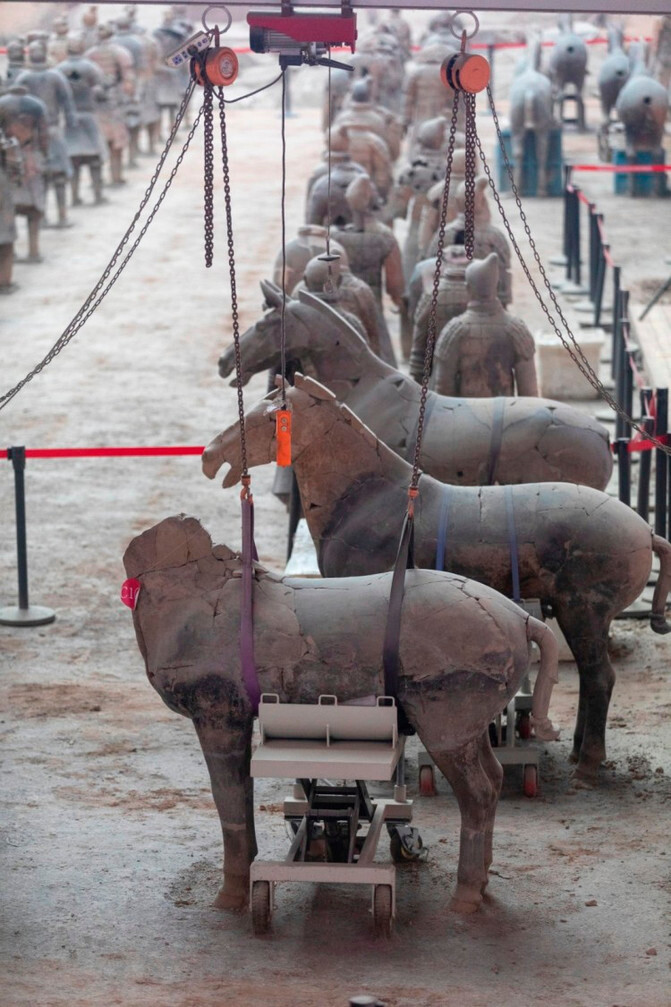
the Terracotta Warriors and horses Museum

The second hall of the museum is the cavalry camp of Qin Shi Huang's special forces army. The cavalry array is neatly arranged in a row of four horses. The cavalry stands in front of the horses, tall and straight, majestic, and the formation is more complex and the arms are more complete. It is the most spectacular army formation among the three pits.

The "treasure of the town" of the Terracotta Army Museum is this kneeling figure. The clothes and hair are clearly visible. It is the most completely preserved and the only one that has not been repaired manually. It is said that thanks to its low profile, it was fortunately preserved during the collapse.
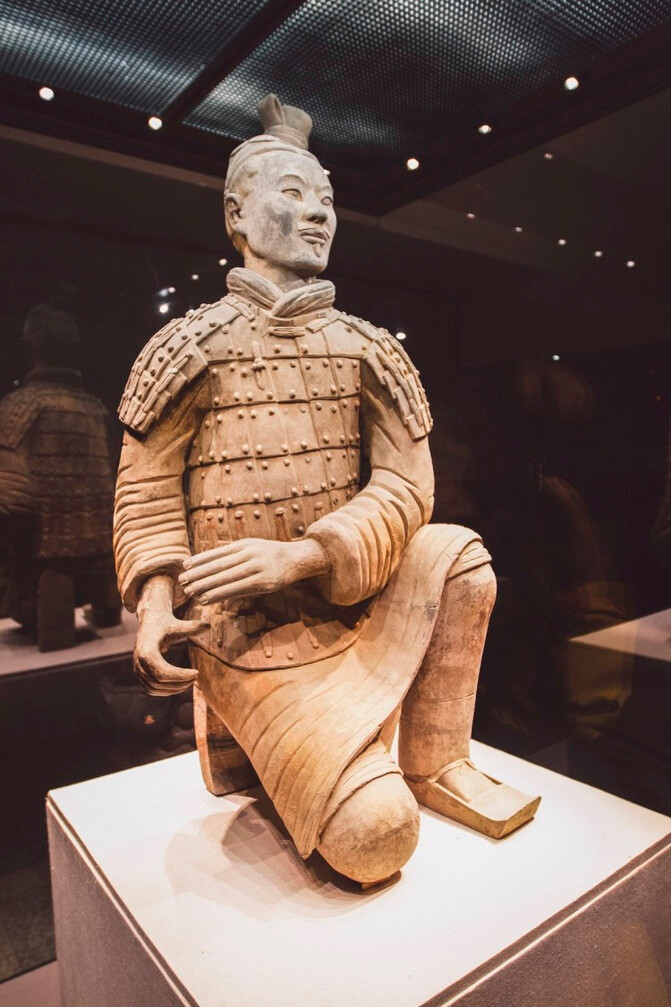
Pit 3 has the smallest area and consists of north and south wing rooms and chariot houses. There is a four-horse chariot and four terracotta warriors in the chariot houses. A total of 68 terracotta warriors can be unearthed in Pit 3.

Judging from the internal layout, it is the headquarters of Pit No. 12. It is the only one among the three pits that has not been burned by fire. Therefore, when unearthed, there are more painted paintings on the pottery figurines, which are relatively bright. It is reasonable that high-ranking officials were also unearthed. The bronze sword equipped with it is extremely sharp.

the Terracotta Warriors and horses Museum

the Terracotta Warriors and horses Museum

the Terracotta Warriors and horses Museum

the Terracotta Warriors and horses Museum

[Qin Shihuang Mausoleum Cultural Relics Exhibition Hall]
The most famous thing displayed in the museum is the bronze chariots and horses, known as the Bronze Crown. It can be said to be the most expensive chariot in the world.

There are two copper chariots and horses in the exhibition hall, one small and the other large. The small is a road-clearing carriage, and the large is a carriage for the owner, also called a carriage. Car No. 1 is the authentic product, and car No. 2 is a product restored based on historical and cultural relics.


There are four horses in front of each carriage, two in the middle are called Fu horses, and two in the outside are called Can horses. There is an ornamental ring on the top of the right Can horse. The decorations on the head of the ancient emperor's carriage are status and power. symbol.

The bronze chariots and horses are imitated according to the shape of the "five-hour auxiliary chariot" in the chariot royal carriage of the Qin Dynasty, symbolizing part of the emperor's chariot. The length and size are half of the real chariot and chariot. The people, horses and chariot are all imitated in bronze and equipped with a large number of gold and silver ornaments.

Outside the scenic area, there is the Qin Academy of Terracotta Warriors and Horses, where you can personally experience the making of a Terracotta Warriors. Of course, it basically uses modern simple craftsmanship. At the beginning, there will be staff who will provide several complete explanations of the Terracotta Warriors and Horses, at least a deeper understanding of the Terracotta Warriors.

the Terracotta Warriors and horses Museum

The steps of making terracotta warriors, knocking mud, taking mud, kneading mud, pressing, demoulding, refining and finished products are children's favorite experience items!
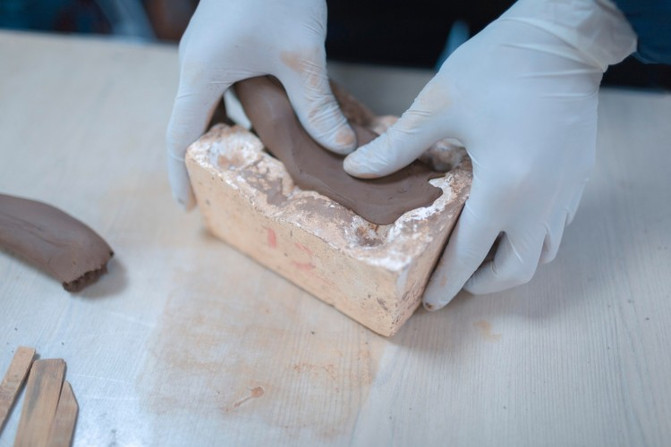
the Terracotta Warriors and horses Museum

The terracotta warriors do not need to be fired. After being air-dried for a few minutes, they can be shaped and taken home as a souvenir.

the Terracotta Warriors and horses Museum

the Terracotta Warriors and horses Museum

the Terracotta Warriors and horses Museum

In the Qinhuang Grand Theater, you can enjoy the large-scale song and dance performance of "The Love of the Qin Terracotta Warriors" and appreciate the story of the Terracotta Warriors more intuitively and vividly.


The latest upgraded version of "Qin terracotta warriors" follows a resurrected Qin terracotta warrior, travels through time and space, and re-appreciates the touching historical stories and emotions in the vast years.

huaqing Palace
Lintong Huaqing Palace Tang Palace Lantern Festival has a charm different from the city wall lantern festival. It talks with the stars and dances with Lishan Mountain. The Tang Palace Lantern Festival is adapted to local conditions and displays more of the court culture and love culture of the Tang Dynasty. Climb Lishan Mountain at night, and 31 large dynamic lights are arranged on Lishan Mountain, making people dizzying.

The perfect integration of technology and traditional lanterns has brought many highlights to the Tang Palace Lantern Festival. Activities such as dream light shows and drone light shows have been all-round and multi-angle recreated in the prosperous world.

When you step into Wangjing Gate, you will be greeted by the "Shengshi Tang Palace" built along the water. The large-scale dynamic main light set of "auspicious elephants Ruyi" allows tourists to dream of returning to the Tang Dynasty through the images of auspicious elephants, wandering dragons, and imperial concubines. In the prosperous times, feel the prayers of good luck and happiness.


Xi'an Huaqing Pool Scenic Area

Xi'an Huaqing Pool Scenic Area

Multiple sets of lamp sets such as elegant sound of the Tang Dynasty, love at first sight, love with my heart, destiny Magpie Bridge, and imperial concubine taking a bath create the grand momentum of the Tang Palace in a prosperous age and demonstrate the prosperity of the Tang Dynasty during the Tang Dynasty.
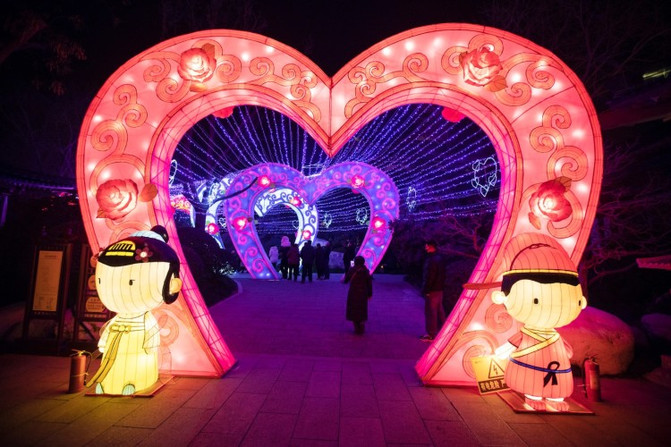
Xi'an Huaqing Pool Scenic Area
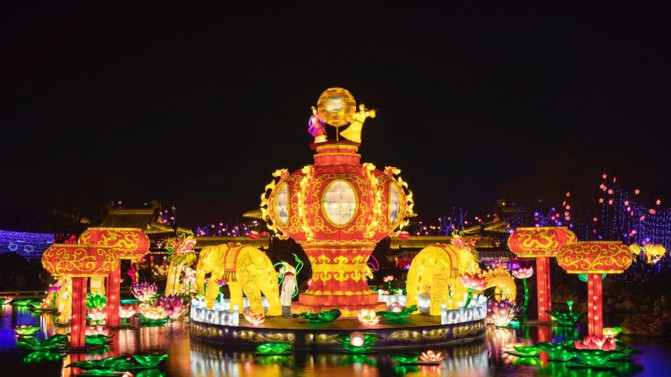
Xi'an Huaqing Pool Scenic Area
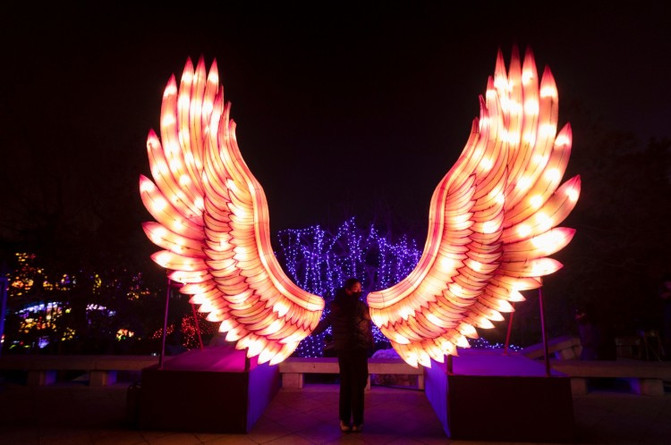
Large-scale lamp sets such as moonlight in the lotus pond, walking horses and bows, praying for blessings and oaths, flying in pairs, lotus in the water, shining in the Li Palace, Shengyou Tang Palace, and drunkenness of the imperial concubine, show Li and Yang's thousand-year-old love, as well as the economic prosperity of the Tang Dynasty. Strong national strength and national confidence.




The theme of Liyuan culture is Liyuan, and the design features large-scale dynamic light sets such as Liyuan Immortal Banquet, auspicious mouse celebrating the New Year, Liyuan Spring Festival, Music Square Hundred Operas, and Fairy Music Piao. Traditional light sets are used to display the profound culture of Liyuan and spread the cultural charm of Chinese opera art.

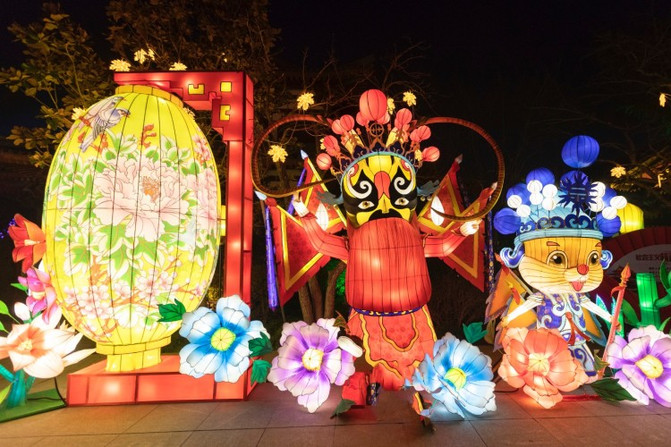
Various lanterns are hung in the Royal Lantern Area, which show the glorious moments of different emperors 'governance, such as the rule of Wenjing and Zhenguan.





Visiting the lantern festival and guessing lantern riddles are definitely the first choice for New Year customs. One after another interesting riddles, I personally feel the charm of traditional culture. The colorful lights illuminate my heart, and laugh with everyone to experience the infinite beauty of the New Year.

Xi'an Huaqing Pool Scenic Area

Xi'an Huaqing Pool Scenic Area

The Lantern Festival will naturally include children's cartoon parks, simulating dynamic dinosaurs, humanoid elephants, humanoid dinosaurs, etc., showing a colorful world of children's fun. Especially the appearance of humanoid elephants and dinosaurs will definitely attract children to stop.

Xi'an Huaqing Pool Scenic Area

On the stage of the tower,"Qin Opera" sang loudly and powerfully.

Xi'an Huaqing Pool Scenic Area

The Xi'an Incident Cultural Zone has profound red historical educational significance, and parents and children can entertain and teach while playing. Through light projection shows, light carvings, light groups, etc. with the historical theme of the "Xi'an Incident", we commemorate the great achievements of the martyrs and express our tribute to the patriots.

Longteng Lishan, the highest and largest mountain dragon lantern group in China, is like an auspicious dragon taking off on the wind in Lishan.

The drone dream light show shows that drones form a variety of dancing shapes such as starry sky, wingbird, and Huaqing Palace. It uses keywords such as Lishan Mountain in Love, Tang Palace Night Banquet, and New Year Carnival to create a wonderful aerial light and shadow show. Dance Lishan together with the bright stars.



Xi'an Huaqing Pool Scenic Area

Xi'an Huaqing Pool Scenic Area

Day 3 Seoul Lake Scenic Area
Xi'an was called Chang' an in ancient times. It was the capital of thirteen feudal dynasties including the Western Zhou Dynasty, Qin, Han, and Tang Dynasty. When talking about Chang 'an City in Xi'an, it refers to Chang 'an City in the Tang Dynasty. If it is Chang' an City in the Han Dynasty, we should especially talk about Chang 'an City in the Han Dynasty.
As the saying goes: East Chang 'an, West Rome, and Han Chang' an were the starting point of the ancient Silk Road. At that time, it was the world's first city with a population of over one million and the world's earliest international metropolis.
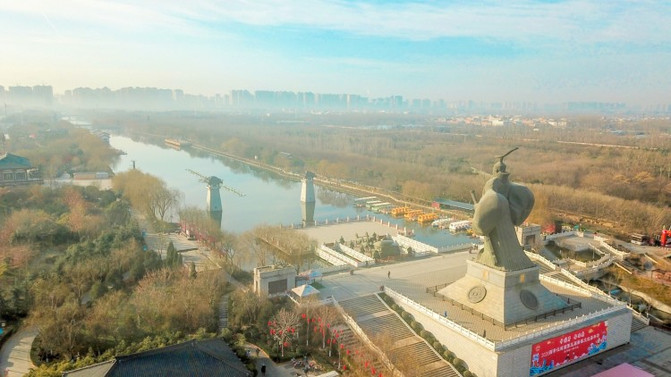
Nowadays, in the vast Han Chang 'an City, the former Gaotai towers and towers have disappeared. However, the Han Chang' an City ruins are the largest, most completely preserved, the richest ruins and the highest cultural content of the capital city in my country. It is a core position of the Chinese nation. Historical and cultural treasure.
It is precisely in order to better protect this cultural site that there is basically no commercial development in the northern suburbs of Xi'an, making the northern suburbs a good place for Xi'an City to appreciate the rural customs. When the flowers bloom in spring, you can enjoy flowers in the spring and fly paper kites. Hancheng Lake Park is the first choice.

From Anmen to Qingmingmen, it was originally Tuanjie Reservoir. It was the moat the eastern section of the southern city wall of Chang 'an in the Han Dynasty and the southern end of the eastern city wall. It was later transformed into the beautiful Hancheng Lake Park, like a small Jiangnan on the Guanzhong Plain.

The entire Hancheng Lake Park is surrounded by the ruins of Chang 'an City of the Han Dynasty as the core, creating seven functional areas: Fengchan World, Baicheng Colorful, Hanqiao Water Town, Corner Tower with Green, Imperial Scenery Covering Angles, Flowing Light Accompanying Bay, and Anmen Shengshi., to showcase the profound Han culture.
There are seven entrances to Hancheng Lake. It enters the scenic area from near the Qingming Gate in Chang 'an City of the Han Dynasty. It is the Fengshan World Scenic Area. The iconic Silian Han Castle comes face to face. The three characters of Hancheng Lake are written on it. There is a wide passage through the Han Castle, where some large-scale activities such as lantern festivals and temple fairs are often held here.
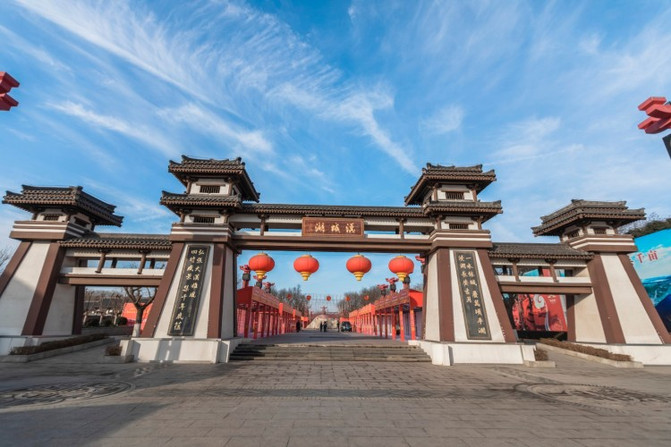

Liu Bang, the ancestor of the Han Dynasty, was from Pei County, Xuzhou. Pei County is also my hometown. Seoul Park and Han Street were also built there. The architectural style is the same as here. When I came to the place where my fellow villager Liu Bang once started a business, I felt a little more cordial.
From afar, I can see the sculpture of Emperor Hanwu standing on the high platform, and the early morning mist shrouded the Seoul Lake.
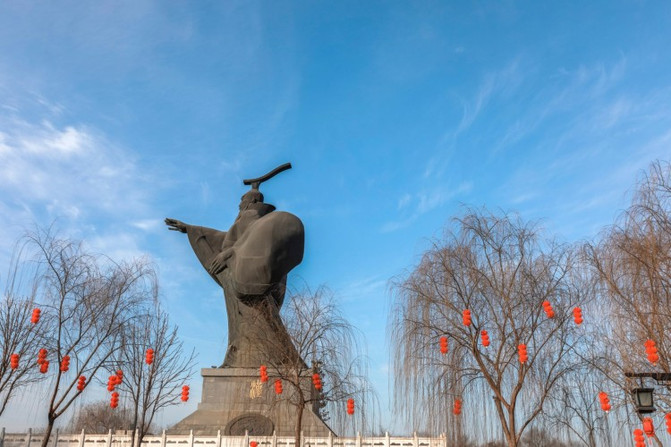
The statue of Emperor Wu of the Han Dynasty faces north and south, holding a sword in one hand to stabilize the border, and using the other hand to shine on all living beings, demonstrating the heroic spirit of Emperor Wu of the Han Dynasty who unified the country and had thousands of miles in mind.
The statue of Emperor Wu of Han is 21.5 meters high, symbolizing the 215 years of rule of the Western Han Dynasty. The base is 7 meters high, implying that Liu Che of the Han Dynasty was the seventh emperor of the Western Han Dynasty. This statue is also the largest among the portraits of Chinese emperors.
There are two Fengshan towers built in Seoul Lake. The towers are 10.9 meters high and there is a musical fountain in front of the towers. Starting from 8:30 every night, three chapters: "The Heroic Style of Hanwu","The Rhythm of Green Lake Water" and "Scenery of Prosperity in Prosperity" are passed. It vividly displays the majestic national style of the Han Dynasty and the heroic spirit of the Emperor Hanwu.
Seoul Lake is characterized by being water-friendly. You can go boating on the lake and walk among the green trees and willows to experience the charm of Jiangnan under small bridges and flowing water and boats under bridges.

In the moral lecture hall, you can experience some activities in Han costumes and Ming and Han ceremonies. This is also an important project for parent-child study and visit ancient times.
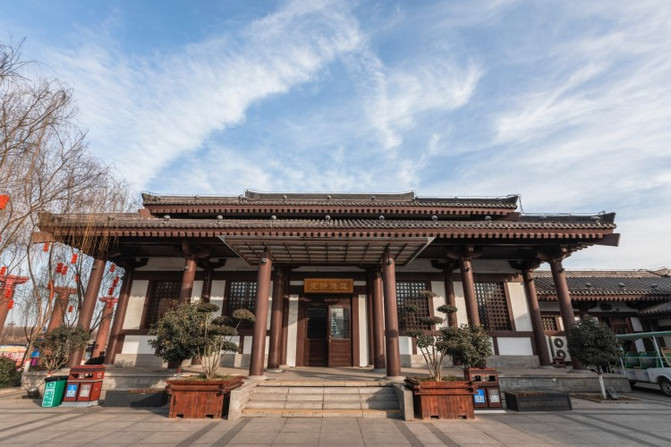
Under the leadership of the teacher, I wore Han-made costumes and relived the etiquette culture of the Han Dynasty.

After the ceremonial activities, you can continue to wear Hanfu to visit Hancheng Lake Park and record the appearance of your lower body wearing Hanfu along the way. From Fengchan Tianxia Scenic Area all the way to the south, there are three ways to visit the park: cruise ship, walking, and sightseeing bus.

After passing through scenic spots such as Bacheng Yicai, Hanqiao Water Town, etc., you will come to Dafeng Pavilion. The strong wind blows and clouds fly in the sky. It is in the sea that you return to your hometown. How can you find brave soldiers guarding the four directions? Dafeng Pavilion, which means "Gale Song", is the commanding height of the Hancheng Lake Scenic Area. Climb up and look into the distance, you can have a panoramic view of the entire Han Chang 'an City ruins and the northern suburbs of Xi'an.

Dafeng Pavilion, a landmark building in Seoul Lake, has a total construction area of 9442 square meters, a building height of 64 meters, two floors underground and seven floors above ground. Opening hours: 9:00 to 17:30, and ticket price is 50 yuan.


Hancheng Lake Scenic Area

There is a multimedia demonstration project of "Han Dynasty Sky City" in Dafeng Pavilion. Pictures and objects of Han Dynasty costumes, Han Dynasty military affairs, Han Dynasty emperors, Han Dynasty allusions, etc. are displayed on the fifth, sixth and seventh floors. There is an indoor scene of the Han Dynasty on the first floor where you can take photos. After taking photos, you can change here and return the Han clothes you wore before.

At the foot of Dafeng Pavilion is the ruins of the southeastern corner of Chang 'an City in the Han Dynasty. The corner tower is an auxiliary building often seen in buildings. This kind of building is mainly located at the corners of defensive buildings, hence the name "corner tower". The ruins of the southeastern corner of the Chang 'an City Wall in the Han Dynasty are about 20 meters from north to south and 23.5 meters from east to west. They are built of rammed earth. The south and north of the corner towers are connected to the south and east city walls respectively.

The road from Dafengge to the west is mostly embossed sculptures, with scenic spots such as Imperial Scenery Fu Ang, Flowing Light Accompanying Bay, and Anmen Shengshi.

Hancheng Lake Scenic Area

yongxingfang
Chang 'an City, Chang' an City in the Tang Dynasty, was divided into three parts: Palace City, Imperial City and Waiguo City. Gongcheng is the emperor's palace area, the Imperial City is the seat of the Central Government Office, and Waiguo City is full of temples, mansions and private houses. There are 14 east-west and 11 north-south streets, dividing Waiguo City into 108 squares. There are two other cities-Dongshi and Xishi, each occupying two squares. Yongxing Square is one of the 108 squares. It is located under the root of the east wall of the Imperial City. It is the former site of Wei Zheng's Mansion in the Tang Dynasty. In the long song of the prosperous age of Zhenguan, it is known as Wei Zheng, the prime minister of the generation known as the King and Human Mirror.

At the entrance of Yongxing Square, there is Jingjian Square as a memorial. People use copper as a mirror to straighten their clothes, use ancient times as a mirror to see the rise and fall, and use people as a mirror to know the gains and losses. This is the highest evaluation of Wei Zheng by Emperor Taizong Li Shimin.

Today's Yongxing Square is an antique "Fang and Si" building. It combines Guanzhong archway and building groups with folk traditions to restore the ancient Li Fang layout, displaying the neighborhood form, historical life atmosphere, and traditional folk living space of the ancient Chang 'an City.

Yongxing Square is full of traditional folk customs, intangible cultural heritage food, and cultural performances. You can see the strong New Year flavor and prosperous scenes everywhere.



There is a Yongxingfang Hundred Theater at the entrance of Yongxingfang. Sit in the open-air teahouse and enjoy Shaanxi folk performances.

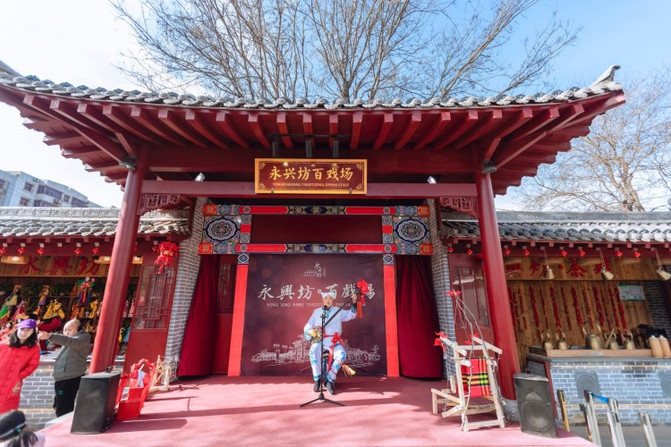

There is a theater in front of the 11008 Square in Guanzhong Lane in the West, and various performances are also held.

Facing south, the theater building is an underground food museum that displays delicious snacks from various counties and cities in Shaanxi, and you can also enjoy shadow puppets




Xi'an's Food Street has Hui Street in the west and Yongxing Square in the east. Different from the halal snacks and commercialization of Hui Street, Yongxing Square has become a new food specialty district that must check in for tourists in Xi'an.
Yongxing Square is the real food street I have ever seen. There are no grilled squid, stinky tofu, or Taiwanese roasted sausages here. Every restaurant does not duplicate the same samples. It brings together various authentic delicacies from 107 districts and counties in Shaanxi, many of which are famous intangible cultural heritage foods in Shaanxi.

Shaanxi is divided into three regions geographically. South of the Qinling Mountains is southern Shaanxi, north of the Qinling Mountains is northern Shaanxi, and northern Shaanxi is divided into Guanzhong and northern Shaanxi by Ziwuling. Due to different geographical locations, the food culture between the three is also very different.
The entire Yongxing Square is divided into clear areas. According to different areas in Shaanxi, it is divided into Shannan Street, Shanbei Lane, and Guanzhong Lane. It is convenient for everyone to choose their favorite delicacies according to their own tastes. Because there are too many delicacies here and must be targeted. You can see the guide map and queuing directions, ancient store tips... guide the direction of the foodies.
Southern Shaanxi is located in the mountainous area south of the Qinling Mountains. First, it loves to eat sour food, second, it loves to eat meat, and third, it loves to drink alcohol. Its diet is close to the habits of Sichuan, Hubei and Chongqing, and rice is the main food.
Representative delicacies include-Ziyang steamed basin, Hanyin Huoshi boiled soup, Zhashui potato glutinous rice cake, Zhenba kang potato, Hanyin kang kang steamed buns, Ankang steamed noodles, Hanzhong hot dough noodles, vegetable tofu, spicy konjac, etc.
White Huoshi Blanking Soup is a typical method of stone cooking. The stone pot contains pork, mushrooms, pakchoi, tofu, and the ingredients include egg white, rice flour, fungus, ginger, seasonal onions, wolfberry, red dates, etc., covered with gauze

Pour in the stock, and then heat it with a 300-degree red white flint. After five minutes, the cooked blanch has beautiful color, delicious soup, and good taste.
The place where bowls of wine are smashed is still crowded with people, and the number of tourists lining up to watch is only increasing. Each bowl of wine is 5 yuan. The wine is a slightly sweet low-alcohol rice wine with almost no alcohol. In fact, the wine is not the focus. What everyone enjoys is just an interactive sense of ritual.

At the entrance to the queue, there is a step chart for breaking a bowl of wine. The first step is to take the wine; the second step is to face the east, lift the bowl above your head, close your eyes, and silently recite your wishes in your heart; the third step is to drink the wine in one gulp; the last step is to drop the bowl and say aloud: "After drinking the bowl of wine, you will have everything at home!"

After drinking the bowl of wine, write a prayer sign and hang the New Year's prayer on the prayer wall.

Ningqiang Thousand Hammer Crispy is made with high-quality peanuts, sesame seeds, walnuts, melon seeds, rock sugar, osmanthus powder, honey, etc. as raw materials. It is slowly boiled in a pan with low heat until it is thick, then placed on a chopping board, sprinkled with a layer of dry powder, repeatedly beating it with a large mallet more than a thousand times, and then shaped, cut into pieces and bagged.

The three hammerheads danced on the Thousand Hammer Crisp, but they couldn't fight. It's amazing. The shouts of the old masters when beating had a special flavor and rhythm, giving a strong Shaanxi style.
The potato glutinous rice cake is made by placing cooked potatoes on a stone nest or stone slab and mashing them into mud with a wooden mallet. It tastes fragrant, sweet and delicious. The potato glutinous rice cake can also be kneaded into meatballs and made into steamed buns. It tastes delicious.


[Northern Shaanxi]
The thick yellow soil, the simple folk customs, the high Qin opera, and the distant Xintianyou are unique characteristics of northern Shaanxi. Representative delicacies include Zichang pancakes, Zizhou dumplings, potato wipes, and naked oats.
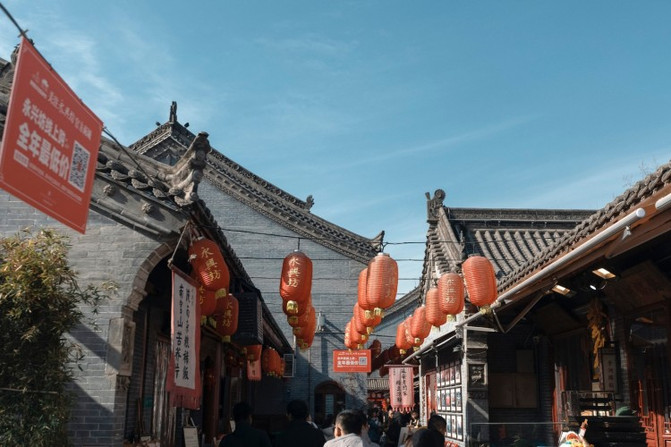

The man smoking a cigarette bag and wearing a white turban sat on the hot clay kang and tasted the delicious Zichang pancakes, which instantly brought people to the land of northern Shaanxi.


Zichang pancakes are made of buckwheat, as thin as paper and as white as silver. Various types of pancakes are formed by mixing pig's head meat, braised pork, crispy pork, chicken, stir-fried vegetables, salad, hot tofu, dried tofu, etc., which are served with vinegar, garlic soup, leek flowers, spicy oil, tomato sauce, sesame seeds, etc.


Suide's yellow steamed buns were published on CCTV's "A Bite of China". Our hometown would also make such yellow steamed buns during the Chinese New Year, but they were made of corn flour and wrapped with bean paste stuffing. Suide's yellow steamed buns are made of soft millet and hard millet millet.

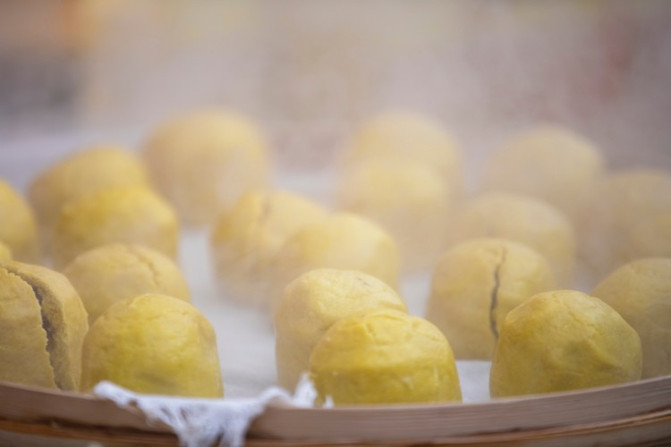
The owner of this store, He Dong, has participated in TV programs such as "Opening the Door","100 Seconds of Gold","Setting for Happiness" and "Avenue of Stars". Many famous hosts and stars have eaten his Dingbian Brewskin.

The steamed skin is thin, bright, and has a strong taste. It is poured with red chili oil, spicy chopped green onion and coriander, and covered with a layer of thin strip-shaped sheep liver. It has hemp in the spicy and aroma in the hemp, which is particularly attractive.
In the Guanzhong Plain, eight hundred miles of Qinchuan, the main food is pasta. Representative delicacies include: biangbiang noodles, Xunyi royal noodles, Jingyang stone steamed buns, Qian County tofu pudding, glutinous rice, Qinzhen rice skin, Xingping Qinjiao Spicy Rice Factory, Buckwheat noodles, Thousand Layer Oil Cakes, gourd chicken, Chengxian Shuipen mutton steamed buns, Qishan dough rolls, Qishan noodles, Tongguan Roujiamo, powder soup sheep blood, small crispy pork, beef cakes, fried jelly, and Dali rice elbow.


Shizi steamed buns are also known as sand steamed buns, hot cakes, and dry steamed buns. They are named after the cake blank is made by being baked on hot stones. It is a legacy of "stone cooking" in the Stone Age. Yuan Mei, a gourmand from Jiangnan, called it a "natural cake" in his "Suiyuan Food List".

Royal noodles in Bin County are different from cold noodles. They are as bright as jade and are called "jade noodles". They are called "Royal noodles" because they are a tribute in the palace.

yongxingfang

yongxingfang

Qianzhou has three treasures: pot helmets, dried noodles, and tofu pudding. In fact, Qianzhou is also rich in sesame flowers, and the raw and crisp ones are better to eat.

yongxingfang

yongxingfang

yongxingfang

yongxingfang

yongxingfang

Wei Zheng Family Banquet
Each of the three areas of Yongxingfang has a main building. Guanzhong Building is the main building of Guanzhong Lane. As the location of Wei Zheng's Mansion during the Tang Dynasty, the Wei Zheng Family Banquet in Yongxingfang is also a special food experience project. You can taste the Wei Zheng Family Banquet in Guanzhong Building.

yongxingfang

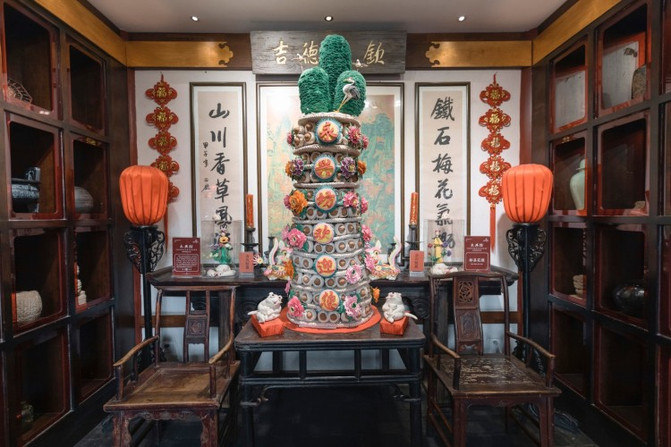
The menu of Wei Zheng's family banquet brings together many authentic snacks, mainly based on exquisite and small food distribution systems, so that you can taste more delicious food to the greatest extent.

yongxingfang

yongxingfang

yongxingfang

yongxingfang

It is said that this was a working meal for officials in the old days when they went to court. Wowotou was made into a miniature version, served with pickled cabbage, fried radish meatballs, braised pork, etc.

The fruit platter eaten steamed has a different taste from raw food and has a unique flavor.

The last highlight is biangbiang noodles. In a large sea bowl weighing several kilograms, there is a bianangbiang noodle that is more than 1 meter long, which makes people can't help but want to eat it.
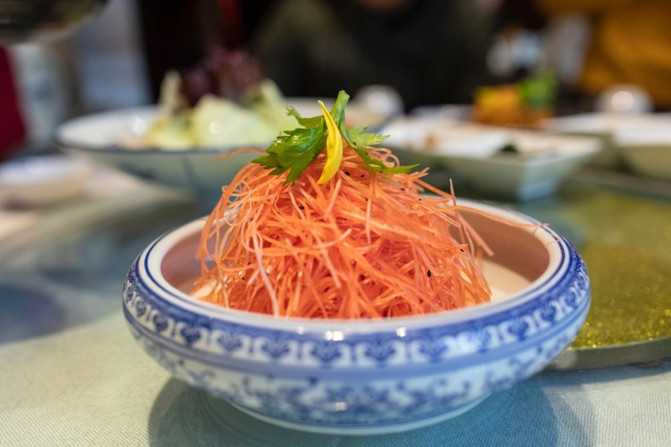
yongxingfang
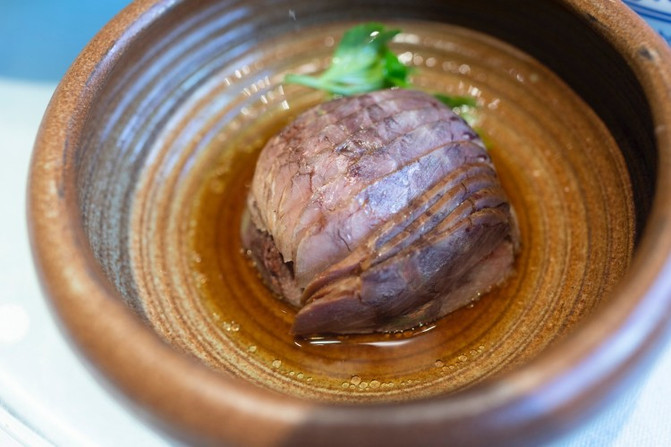

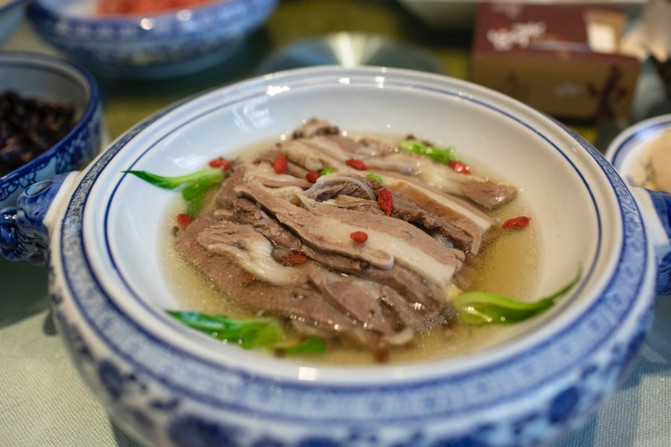

Xi'an zhonglou
The Bell Tower is located at the intersection of East, West, North and South Four Streets. It is a landmark building in Xi'an. You can arrive at the Bell Tower Station of Metro Line 2. The Bell Tower and Drum Tower ticket is 50 yuan/person. It is recommended to check in the afternoon because the night view is beautiful. You can look at the Bell Tower from afar.

Climbing the bell tower, you can overlook the entire city of Xi'an. The bell tower is 36 meters high, while the maximum height of all buildings in the city is 36 meters.


The entire bell tower is mainly of brick and wood structure, built on a square base made of blue bricks and white ash. The building is of a wooden structure. There are 8 embossed on the door leaves on each floor. Each embossed contains an ancient allusion.

The "Morning Bell" performance of the antique ceremonial "hung in the northwest corner of the bell tower: The duration is 15 minutes. At 8:30 a.m., thirteen antique warriors climbed the building and knocked the imitation Tang Jingyun bell for 24 times.




Walking along the Starbucks street at Bell Tower Century Jinhua Plaza, you will see the Drum Tower, where Hui Street is.

The first floor of the Drum Tower is an exhibition hall on the theme of drums. There is a performance of imitation Qin Yuefu chime bells on the stage, which still sounds very shocking.

Xi'an zhonglou


Zui Chang an
Have dinner at Drunken Chang 'an in the evening. Drunken Chang' an Water has recently become a popular Shaanxi restaurant.

Ancient interior decoration

Zui Chang an

Zui Chang an

Zui Chang an

Zui Chang an



Internet celebrity brush crisp

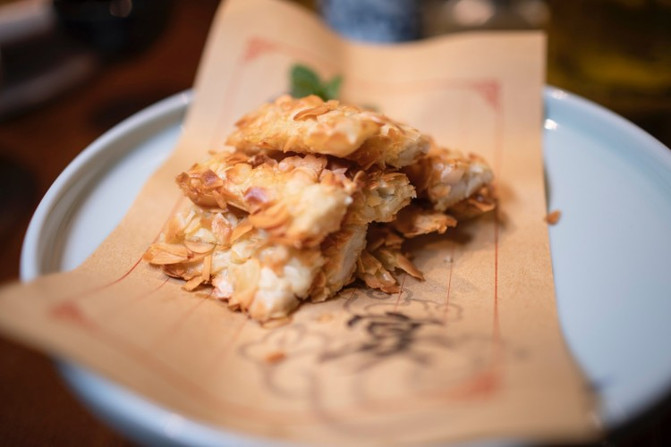
This rice wine is very delicious, you must check in

Shaanxi famous dish gourd chicken


datang Furong garden
The ancient city has a tower, and Huaqing is based on Mount Li. The New Year Lantern Festival in Furong Garden of the Tang Dynasty relies on water. Furong Lake accounts for one-third of the area. Thousands of lanterns decorate the water and sky. The lights flow in the water, boats swim in the lights, and people walk in the lights.
datang Furong garden

The peacock lantern at the entrance of Furong Garden is the world's Guinness certified "the world's largest vertical lantern". It is magnificent and has fluttering brocade feathers.
The Tang Dynasty Furong Garden has set up nearly 60 sets of light groups, with six themes: Shengshi Guoyun, Cool Play Tang Chao, Tiandeng Street Light Market, Gengzi New Year, Dream Forest, and Yaochi Reflecting the Moon. Fish lanterns, palace lanterns, row lanterns, and falling yarn lanterns can be seen everywhere, vividly restoring the style of the Tang Dynasty in the drama "Chang 'an Twelve Hours".

The most fascinating thing is the "Dragon and Phoenix" hovering on the White Jade Furong Bridge. It flies in the sky, with light and shadow reflecting each other, and walking on it feels like you are immersed in it.

The "boat tour style" lantern viewing route with the theme of "Chasing Dreams of the Tang Dynasty" allows you to appreciate the wonderful charm of walking through lanterns on top of the dragon boat.

datang Furong garden

datang Furong garden

The gold version of the time-domain Tang music and dance drama "Dream Back to the Tang Dynasty" in Xi'an Qujiang Tang Furong Garden is divided into five chapters: "Dream Back to the Tang Dynasty" and "The Fire of Chang' an, the Iron and Blood Heroes Fight Changsha","The National Color and Sky Fragrance, the Huaqing Baths and Condenses Jiuzhou","Prosperous society, Nuo noodles, Chang 'an City","Silk Road Style, the Belt and Road is Beautiful", and "Wedding in a Prosperous Era, Dream Back to the Tang Dynasty Praise the Glory".

datang Furong garden

datang Furong garden

datang Furong garden

datang Furong garden

It tells the romantic love story of a modern girl who travels through time and space to pursue her dream lover, Chang 'an. From multiple dimensions such as war, song and dance, market, Maritime Silk Road, weddings, etc., the audience deeply interprets a prosperous Tang Dynasty full of twists and turns.

datang Furong garden

datang Furong garden

datang Furong garden

datang Furong garden

datang Furong garden

datang Furong garden

datang Furong garden
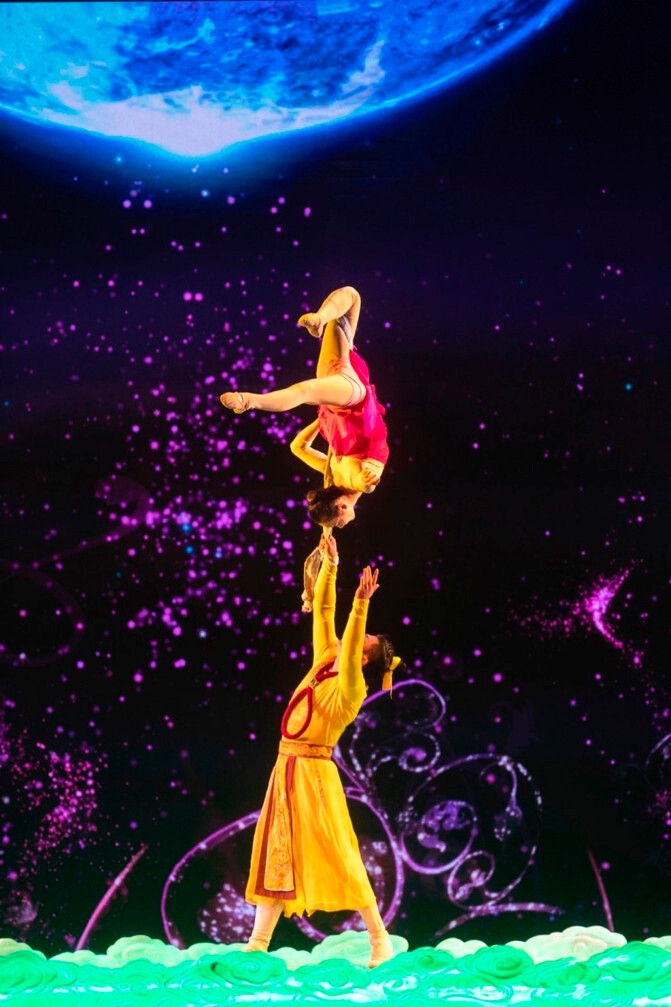
datang Furong garden

datang Furong garden

datang Furong garden

datang Furong garden

datang Furong garden

datang Furong garden

datang Furong garden

datang Furong garden

datang Furong garden

datang Furong garden

datang Furong garden

datang Furong garden

datang Furong garden

datang Furong garden

datang Furong garden

datang Furong garden

datang Furong garden

datang Furong garden



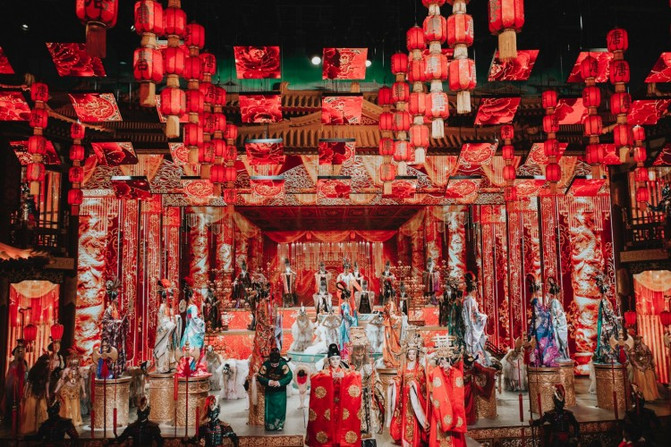
datang sleepless city
To experience Xi'an's nightlife and charming night scenery, be sure to check in the Tang Dynasty that never sleeps.

With cities, mountains, water, and cities, the Tang Dynasty's sleepless city, which is crowded with tourists, is full of a strong atmosphere of fireworks. The tumblers, who are popular all over the Internet, attract countless Chinese people to check in just to hold the tumblers 'hand. In "Chang' an Twelve Hours", there are such familiar pictures of singing and dancing on the street.

Relying on the Big Wild Goose Pagoda, the Tang Dynasty Sleepless City starts from Xuanzang Square in the north, ends at Tang City Wall Ruins Park in the south, starts from Cien East Road in the east, and ends at Cien West Road in the west. It runs through Xuanzang Square, Zhenguan Cultural Square, and Kaiyuan Celebration Square in three theme squares, six imitation Tang blocks and four cultural buildings, Xi'an Concert Hall, Xi'an Grand Theater, Qujiang Film City, and Shaanxi Artists Exhibition Gallery.


Qilaichao Sculpture




The fire trees and silver flowers are closed, the iron lock of the Star Bridge is open, and the city that never sleeps in the Tang Dynasty is also the fire trees and silver flowers, with bright lights and carnival all night long.

Lady Parade

datang sleepless city

datang sleepless city
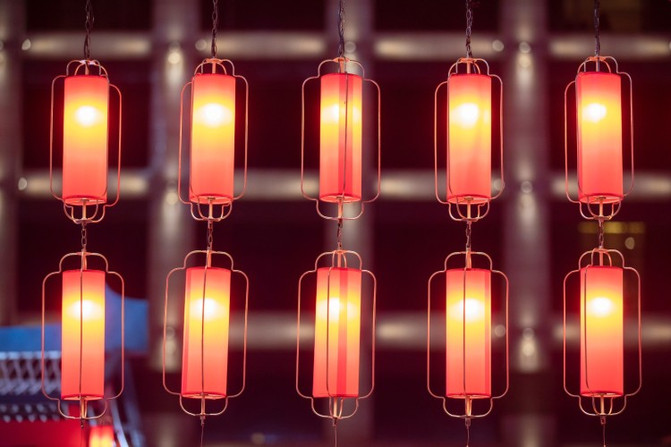
cabaret

datang sleepless city

datang sleepless city

Only by walking through the Tang Dynasty Sleepless City can you feel the charm of Xi'an as a newly popular tourist city. Here, you can enjoy the wonderful performances of many bands and Internet celebrity singers, and fans are playing Call crazily under the stage.

datang sleepless city

datang sleepless city


datang sleepless city
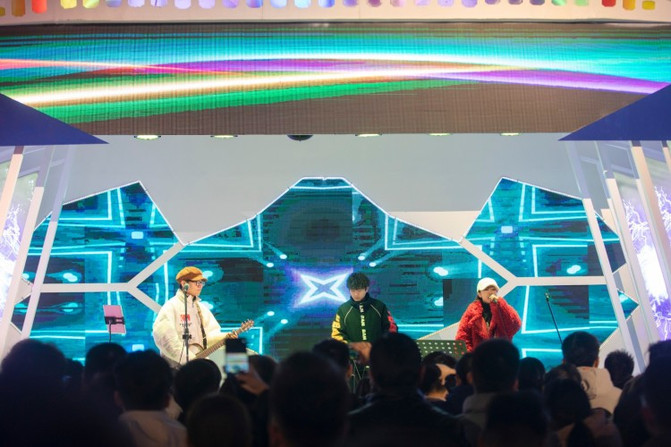
Release yourself to your heart's content in Shouquan and shout out your New Year wishes.


The trip to Xi'an is over, thank you for enjoying it!
Previous Article:[Xi'an] The prosperity is endless, lost in the night of the thousand-year-old ancient capital
Next Article:202010 Xi'an Five-Day Free Tour
